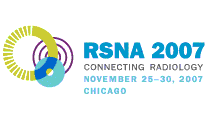
Abstract Archives of the RSNA, 2007
Anuj Goenka, Presenter: Nothing to Disclose
Patients with nodal metastases from an unknown primary squamous cell carcinoma of the head and neck pose a therapeutic challenge to the radiation oncologist. Many centers offer comprehensive mucosal and nodal irradiation to these patients in order to minimize the risk of locoregional failure. We present our experience in treating patients with ipsilateral nodal metastases with radiation to the involved neck and ipsilateral head and neck mucosa alone.
Between 1993 and 2006, 29 patients with newly diagnosed biopsy-proven squamous cell carcinoma in the cervical lymph nodes from an unknown primary were treated with radiation therapy either definitively or after neck dissection. All follow-up records at Johns Hopkins Hospital from date of treatment were reviewed for the following endpoints: loco-regional control, distant control, overall survival, and persistent xerostomia. Patients were staged according to the American Joint Committee on Cancer (AJCC). Patients with ipsilateral disease at time of presentation were assessed for risk of a nasopharyngeal primary by the following criteria: lymphadenopathy in the posterior cervical triangle, ethnic Asian origin, lymphoepithelioma histology, and elevated EBV titers.
21 of 29 patients with ipsilateral nodal metastases who were deemed to be at low risk for a nasopharyngeal source of their neck disease underwent neck dissection with or without directed biopsies (86%). Patients were irradiated to the involved neck and ipsilateral head and neck mucosal sites, including Waldeyer痴 ring, to a median dose of 60 Gy. Estimated 5- year locoregional control rate was 81.2% and 5-year distant control rate was 95.2%. 11.1% of these patients had persistent Grade 3 or 4 xerostomia greater than one year after treatment. Two patients experienced emergence of an occult primary after treatment, one in the ipsilateral base of tongue, and the other in the contralateral retromolar trigone.
In well selected patients, the utility of treating the involved neck and ipsilateral head and neck mucosal sites alone in patients with ipsilateral cervical nodal metastases from an unknown primary head and neck cancer is associated very good locoregional control. Such an approach may be a feasible alternative to comprehensive head and neck irradiation in this patient population. Additionally, this technique confers lower rates of late grade 3 and 4 xerostomia.
Goenka, A,
Management of Unknown Primary Head and Neck Carcinoma with Radiotherapy to the Involved Neck and Ipsilateral Mucosal Sites. Radiological Society of North America 2007 Scientific Assembly and Annual Meeting, November 25 - November 30, 2007 ,Chicago IL.
http://archive.rsna.org/2007/6000935.html
Accessed August 26, 2025

